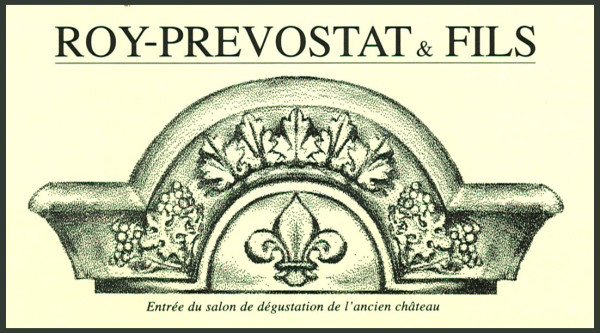The Estate
This is one of the most ancient estates, in one of the oldest terroirs, in Chablis. This location was where, 1,000 years ago, monks from Pontigny originally made their selection to create the Chablis appellation.
For 4 centuries, Domaine Roy-Prevostat has been making wine, passing their methods from father to son. The current owner perpetuates the secular and familial traditions on these great monastic appellations. The working of the vines remains traditional because he believes a clean and healthy vineyard renders good quality grapes and wines.
Named for the proprietor’s two grandmothers, the domain is 28 hectares, and is planted with Chardonnay vines on Kimmeridgian soil (Jurassic period clay-limestone strata with fossilized seashells). It is situated on a hill with high slopes, exposed to the southeast. This is beneficial for Chablis wines, as it protects the vines from the chill that comes in the spring, and exposes them to early morning sunlight.
Harvest
Harvest at optimum maturity; machine harvest is preferred in order to maintain skin contact on the juice. Sorting is done to eliminate all green/rotten grapes.
Vinification
Slow pressing for 3 hours and separation of the cuvées, keeping only the “Tetes de Cuvées.” 3 weeks of alcoholic fermentation in natural environment, using natural yeasts, at low temperatures (18°C) to preserve the natural glycerol from the grapes and their floral aspect. Malolactic fermentation is systematic in order to avoid all risks of fermentation in bottle. The bâtonnage on fine lees is done each month for a period of 18 months, without sulphites–only with the carbonic gas kept from the malolactic fermentation. This autolysis of the lees enriches the wine with good aromas from the terroir. Filtration and fining are not systematic, and the bottling is accomplished under nitrogen.
Aging
The wines are preserved for 6-12 months before being sold. At this point, the Chablis is 2 years old and the Premiers Crus are between 5-8 years old.
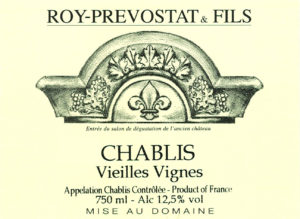
Chablis Vieilles Vignes
Location: Situated in northern Burgundy, Auxerre. 180 kilometers (110 miles) south of Paris.
Soil: Kimmeridgian Marl
Exposition: South, southeast, and southwest
Climate: Semi-continental climate, slightly influenced by the Atlantic Ocean. Winter is long and cold, spring has much precipitation, and summer is very hot with strong sun exposure. The vines need to be strong enough to withstand hail and spring frost damage.
Grape Variety: 100% Chardonnay
Vinification: Grapes are pressed, followed by alcoholic fermentation using natural yeasts at a temperature of 18°C for 3 weeks. Malolactic fermentation is 100% achieved. Stirring of fine lees each month for 1 year.
Tasting Notes: The almost insolent richness of this Chablis makes it an ideal wine for an aperitif, as well as an excellent companion to fish pâtés, oysters, and other seafood. Also does well with with roasted andouillette or snails of Burgundy with Chablis and butter persillade. Explosive mix of seashore minerality and honeyed orchard fruit; notes of lemon meringue, peanut shell, and créme brulée.
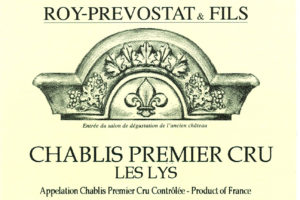
Chablis 1er Cru Les Lys
Location: Les Lys, or “the Lilies”, is a Premier Cru that was once owned by the French monarchy. It is situated at the northeast end of the Vaillons Premier Cru, southwest of the town of Chablis, on the side of a hill.
Production Area: 4.0 hectares
Soil: Chalky clay and limestone-especially high proportion of clay and limestone compared to other vineyards in the area; Kimmeridgian subsoil
Exposition: Southeast
Climate: Cool, continental climate; the sunlight over Les Lys is less intense than in other climats, giving the vines that are planted there a longer, slower growing season
Grape Variety: 100% Chardonnay
Vinification: Grapes are pressed, followed by alcoholic fermentation using natural yeasts at a temperature of 18°C for 3 weeks. Malolactic fermentation is 100% achieved. Stirring of fine lees each month for 18 months in order to concentrate the aromas, giving the wine fullness and enzymic qualities for a long aging.
Tasting Notes: As a young wine, it has the potential to grow and thrive. Its noble heritage is revealed through its purity and harmony of flavors and fragrances. It should be appreciated with simple steamed fish and delicate sauces.
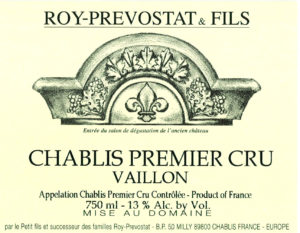
Chablis 1er Cru Vaillon
Location: Vaillons is a Premier Cru vineyard in Chablis, one of the largest in fact (110 ha). Situated on the western side of the Serein River on a southeast facing hill, quite close to the prestigious Montmains Premier Cru
Production Area: 4.0 hectares
Soil: Kimmeridgian subsoil
Exposition: Southeast
Climate: Cool, continental climate; the sunlight exposure over Vaillons is intense in the morning and less so in the afternoons
Grape Variety: 100% Chardonnay
Vinification: Grapes are pressed, followed by alcoholic fermentation using natural yeasts at a temperature of 18°C for 3 weeks. Malolactic fermentation is 100% achieved. Stirring of fine lees each month for 18 months in order to concentrate the aromas, giving the wine fullness and enzymic qualities for a long aging.
Tasting Notes: It opens with fragrant aromas of pear, brioche, beeswax, honey, and sweet spice. On the palate, this wine is ample and elegant, with a lovely minerality. When young, it is the perfect accompaniment to summer cooking. Excellent cellaring potential-patience obtains an exceptional wine.
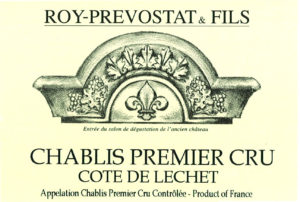
Chablis 1er Cru Côte de Lechet
Terroir: This is a magnificent historical terroir that goes back to the origins of Chablis. Just north of the village of Milly, it has very steep slopes which often preserve the vines from the spring frosts and allow the fruit to ripen early. Exposition is to the southeast.
Production Area: 4.0 hectares
Harvest: At optimum maturity; machine harvest is preferred by the winemaker in order to maintain skin contact on the juice. Sorting is done to eliminate all green/rotten grapes.
Vinification: Long and slow fermentation using indigenous yeasts. After malolactic fermentation is 100% realized, the wines are racked and then kept on the fine lees with batonnage over 2 years. A second racking follows, after which the wine is left to rest in the cellar.
Tasting Notes: Lovely complexity between the minerality and the ripe white fruit, which evolves with age to notes of forest floor and flinty stone.
Food Pairings: Goes well with chicken in a cream mushroom sauce, with truffle risotto, and with aged, raw milk cheeses.
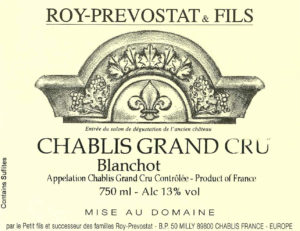
Chablis Grand Cru Blanchot
Production Area: 0.15 hectares
Grape Variety: 100% Chardonnay
Harvest: Harvesting is done at optimum maturity; the grapes that are too young or that have dry rot are eliminated.
Vinification: Slow pressing for 3 hours, separating the cuvees and only retaining the best of the lot. 18 hours of static racking, done naturally and carefully. 3 weeks of alcoholic fermentation with the use of indigenous yeasts. This is done at low temperatures (18 °C) in order to preserve the natural sugars and floral qualities of the grapes. Malolactic fermentation is systematic in order to avoid all risk of re-fermentation in the bottle.
Aging: The stirring of the fine lees with the wine is carried out every month for 18 months, without added sulfur, only with the carbon dioxide preserved and resulting from the malolactic fermentation. The self-destruction of yeasts, called “autolysis”, enriches the wine with aromas specific to its original terroir. Over time, the wine develops a greater fullness as well as tertiary and fresh fruit aromas. Its structure also lends itself to cellaring, which results in strong aromatic persistence and its potential of retro-olfaction. Filtrations and collages are not systematic (they do not remove what they have waited for so long …) and bottling is carried out under nitrogen. The wines are preserved for 6-12 months in bottle before releasing to the market. At that time,the Chablis are about 2 years old and the Premiers Crus about 5-8 years old.
Tasting Notes: Aromas of white flower, linden tree, and broom shrub on the nose. On the palate it is silky and seductive, with notes of honey, freshly churned butter, and a flinty finish.
Food Pairings: Lighter seafood such as white fish and scallops.
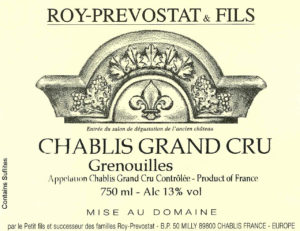
Chablis Grand Cru Grenouilles
Location: The pearl of Chablis! The Grand Cru “Grenouilles” is the most rare of plots in Chablis. It has the best exposition at the top of the appellation, taunting the real grenouilles (frogs) in the valley- these vines reign supreme in the vineyard.
Grape Variety: 100% Chardonnay
First Planting: 1960
Production Area: 0.30 hectares
Harvest: Harvesting is done at optimum maturity; the grapes that are too young or that have dry rot are eliminated.
Vinification: Slow pressing for 3 hours, separating the cuvees and only retaining the best of the lot. 18 hours of static racking, done naturally and carefully. 3 weeks of alcoholic fermentation with the use of indigenous yeasts. This is done at low temperatures (18 °C) in order to preserve the natural sugars and floral qualities of the grapes. Malolactic fermentation is systematic in order to avoid all risk of re-fermentation in the bottle.
Aging: The stirring of the fine lees with the wine is carried out every month for 18 months, without added sulfur, only with the carbon dioxide preserved and resulting from the malolactic fermentation. The self-destruction of yeasts, called “autolysis”, enriches the wine with aromas specific to its original terroir. Over time, the wine develops a greater fullness as well as tertiary and fresh fruit aromas. Its structure also lends itself to cellaring, which results in strong aromatic persistence and its potential of retro-olfaction. Filtrations and collages are not systematic (they do not remove what they have waited for so long …) and bottling is carried out under nitrogen. The wines are preserved for 6-12 months in bottle before releasing to the market. At that time,the Chablis are about 2 years old and the Premiers Crus about 5-8 years old.
Tasting Notes: This is an almost mythical wine with exceptional sensuality. Bold and round with a delicate bouquet and silky mouth feel.
Food Pairings: Only the best for this Chablis – pair it with Ossetra caviar or serve simply as an aperitif.



